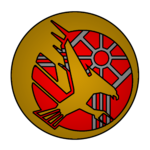List of Cacertian Noble Houses: Difference between revisions
| Line 5: | Line 5: | ||
{{main|House Sarissita}} | {{main|House Sarissita}} | ||
[[Image:HouseSarissitaCrest.png|right|150px]] | [[Image:HouseSarissitaCrest.png|right|150px]] | ||
House Sarissita is the royal house of Cacerta ruling the Successor State of Sarissita. Its members have been the hereditary rulers of the Kingdom since the end of the Unification War in 1871. Founded in 1313, House Sarissita jointly ruled the city-state of [[Vichenza]] alongside [[House Trento]] until a 1654 marriage between the two families consolidated their power. The Sarissita Family was often considered the most economically powerful of the Great Houses, attributed primarily to the fact that Vichenza was the center of trade on the island of Sarissita. Victor Sarissita, in alliance with Cianna Davion, launched a conquest of the Cacertian Archipelago in 1870 which eventually lead to the creation of a unified Cacertian state. The Sarissita family and its politics are often described as adaptable; many of its members and, by extension, the rulers of Cacerta have become popular symbols of the common people of Cacerta specifically stemming from the family's altruism. While the Sarissita’s wealth has never been disclosed publicly, they have become defined by their contributions to improving working class lifestyles and actively participating in stemming homelessness and unemployment. The Great War-era of Tyran history is perhaps the only time that House Sarissita leadership was perceived as poor, mostly a result of the Cacertian Empire’s defeat in the Divide War; this later changed following Cacerta’s joining of the [[Common Sphere]] and the later victory it participated in at the end of the [[Siduri War]]. [[Anelyn Trento|Queen Anelyn I]], the youngest of unified Cacerta’s monarchs, enjoys significant popular domestically and abroad. Her pursuit of a relatively modest lifestyle, her often lack of pomp and circumstance, and impromptu trips around the nation are considered major factors in her well-perceived image. | House Sarissita is the royal house of Cacerta ruling the Successor State of Sarissita. Its members have been the hereditary rulers of the Kingdom since the end of the Unification War in 1871. Founded in 1313, House Sarissita jointly ruled the city-state of [[Vichenza]] alongside [[House Trento]] until a 1654 marriage between the two families consolidated their power. The Sarissita Family was often considered the most economically powerful of the Great Houses, attributed primarily to the fact that Vichenza was the center of trade on the island of Sarissita. Victor Sarissita, in alliance with Cianna Davion, launched a conquest of the Cacertian Archipelago in 1870 which eventually lead to the creation of a unified Cacertian state. | ||
The Sarissita family and its politics are often described as adaptable; many of its members and, by extension, the rulers of Cacerta have become popular symbols of the common people of Cacerta specifically stemming from the family's altruism. While the Sarissita’s wealth has never been disclosed publicly, they have become defined by their contributions to improving working class lifestyles and actively participating in stemming homelessness and unemployment. The Great War-era of Tyran history is perhaps the only time that House Sarissita leadership was perceived as poor, mostly a result of the Cacertian Empire’s defeat in the Divide War; this later changed following Cacerta’s joining of the [[Common Sphere]] and the later victory it participated in at the end of the [[Siduri War]]. [[Anelyn Trento|Queen Anelyn I]], the youngest of unified Cacerta’s monarchs, enjoys significant popular domestically and abroad. Her pursuit of a relatively modest lifestyle, her often lack of pomp and circumstance, and impromptu trips around the nation are considered major factors in her well-perceived image. | |||
===House Davion=== | ===House Davion=== | ||
Revision as of 19:15, 24 January 2022
The Cacertian Archipelago is divided between many hundreds of noble houses of various sizes. In the modern era, ultimate power is held by the monarch of Cacerta who rules the constituent regions and city-states through the noble houses. Cacerta possesses five Great Houses which each rule one of the Kingdom’s five regions, historically referred and known within Cacerta as the Successor States, from their seats of power and who report directly to the crown.
Great Houses of Cacerta
House Sarissita
House Sarissita is the royal house of Cacerta ruling the Successor State of Sarissita. Its members have been the hereditary rulers of the Kingdom since the end of the Unification War in 1871. Founded in 1313, House Sarissita jointly ruled the city-state of Vichenza alongside House Trento until a 1654 marriage between the two families consolidated their power. The Sarissita Family was often considered the most economically powerful of the Great Houses, attributed primarily to the fact that Vichenza was the center of trade on the island of Sarissita. Victor Sarissita, in alliance with Cianna Davion, launched a conquest of the Cacertian Archipelago in 1870 which eventually lead to the creation of a unified Cacertian state.
The Sarissita family and its politics are often described as adaptable; many of its members and, by extension, the rulers of Cacerta have become popular symbols of the common people of Cacerta specifically stemming from the family's altruism. While the Sarissita’s wealth has never been disclosed publicly, they have become defined by their contributions to improving working class lifestyles and actively participating in stemming homelessness and unemployment. The Great War-era of Tyran history is perhaps the only time that House Sarissita leadership was perceived as poor, mostly a result of the Cacertian Empire’s defeat in the Divide War; this later changed following Cacerta’s joining of the Common Sphere and the later victory it participated in at the end of the Siduri War. Queen Anelyn I, the youngest of unified Cacerta’s monarchs, enjoys significant popular domestically and abroad. Her pursuit of a relatively modest lifestyle, her often lack of pomp and circumstance, and impromptu trips around the nation are considered major factors in her well-perceived image.
House Davion
House Davion is the oldest of Cacerta’s five Great Houses with an acknowledged foundation date of 19 June 745 and the rulers of the Successor State of Lombardo. They are often considered the most powerful of the Great Houses in terms of manpower and have significant of the nation’s most powerful military branch, the Royal Navy, as well as several industries such as the Kingdom’s state-owned shipbuilding company as well as Cacerta’s flag carrier. The Davion Family entered into an alliance with House Sarissita during the First Cacertian War of Unification in 1860 and their domination of the seas around the Cacertian Archipelago ensured ongoing alliance victories until the end of the unifications wars in 1871. Many of House Davion’s members have made significant contributions to Cacerta’s growth as a nation, both as active participants in its military as well as technological and scientific endeavors. Andrea Doria was famous for pioneering the transformation of the Royal Navy into a modern fighting force in the aftermath of the Divide War and during its service in the Siduri War whereas members such as Hanna Doria have pioneered new technologies in armaments and marine engineering.
House Marik
House Marik have ruled the Successor State of Venetio from their seat in the city of Molfetta since 1488 and are known for being the last house to surrender during the Unification War. Their house sigil, the Venetio red falcon, is synonymous to martial prowess in the Kingdom and this is reflected by the use of Marik maroon as the primary color of the Royal Army. They have been staunch members of the Ultranationalist Party of Cacerta since its foundation, but are also responsible for the most recent reformation of the Party into the more open-minded Neo-Ultranationalist Movement.
House Viareggio
House Viareggio is the ruling Great House of the Apullia Successor State, ruling from the city-state from which they derive their name. Members of the House have been long-standing political rivals of the Royal House, a rivalry characteristically defined by the two-houses well-developed rapport. House Viareggio controls a large portion of Cacerta’s mineral and industrial market, making it the second richest of the Great Houses. They have been significant supporters of culture and the arts; many members of House Viareggio are recognized for their contributions to the development of Cacerta’s unique national identity.
House Quintilian
House Quintilian rules the Successor State of Abruzzo from the city-state of Carrera. Prior to the Unification War, Abruzzo had been historically ruled by a hereditary dictator—holding the title of Coordinator—who oversaw a domain possessing a fanatical military and a pervasive civilian bureaucracy. Many of the original members of House Quintilian were killed during Carrera’s historical siege which led to a cadet-branch taking up the name of the House and significantly altering its previous ideology. Although Abruzzo is still ruled by a hereditary Coordinator, the modern iteration of the Successor State possesses significant political and ideological freedoms in contrast to its past self.
Minor Houses of Cacerta
House Altoviti
House Arcangeli
House Astrid
House Borgia
House Carignan
House Grantrel
House Padova
Rivalling House Davion, House Padova is one of the oldest of Cacerta’s noble houses and hail from the Successor State of Sarissita. Although the modern-day House was not officially founded until 756, the Padovans are known for being the leading family of the Sabrian Empire and strong proponents of Mos Maiorum. Realizing the expansion of the Makedonian Empire into eastern Siduri directly threatened the mercantile power of Sabria (modern-day Padova), the Padovans fought the First and Second Sabrian Wars. In the Centuries War Period of Cacertian history, the Padovan Empire was a major political faction and remained an independent power until it was finally defeated during the First Cacertian War of Unification. House Padova today are loyal retainers of House Sarissita and are defined by their strong faith in the goddesses of Mos Maiorum.





